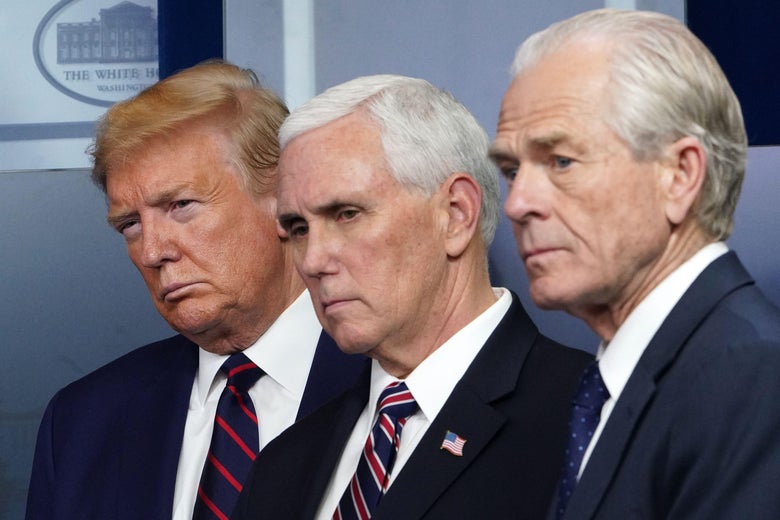
Three heads not being better than one.
MANDEL NGAN/Getty Images
Two memos circulated in the White House in late January and late February show the Trump administration was well aware of the potential dangers of the coming spread of the coronavirus, despite public presidential assurances that all was well. Both memos were authored by President Trump’s trade adviser Peter Navarro. Each outlined, with growing alarm, the coming impact of the virus and each missive was reportedly circulated around the top levels of the White House. The warnings were clear: the “risk of a worst-case pandemic scenario should not be overlooked,” Navarro’s memo dated Jan. 29 cautioned.
The Jan. 29 memo signed by Navarro and addressed to the National Security Council makes plain the stakes of the pandemic. “The lack of immune protection or an existing cure or vaccine would leave Americans defenseless in the case of a full-blown coronavirus outbreak on U.S. soil,” the memo said. “This lack of protection elevates the risk of the coronavirus evolving into a full-blown pandemic, imperiling the lives of millions of Americans.” The New York Times reports that the document was sent to the NSC and reached top White House officials, including then-acting chief of staff Mick Mulvaney, but it is not known if it reached Trump himself. The Jan. 29 dateline on the memo was the same day that Trump named the coronavirus task force to respond to the looming pandemic. The task force is chaired by Vice President Mike Pence and includes many of the officials that are now daily fixtures at the White House briefings on the pandemic response, including Dr. Deborah Birx and Dr. Anthony Fauci.
A week before the memo, on Jan. 22, Trump told CNBC “we have it totally under control” and “it’s going to be just fine.” Navarro’s missive is one of the first reported documents that gives some insight into what the people around president, and potentially Trump himself, knew in the early stages and what information the White House was responding to, despite public denials that there was anything to worry about. In the document, Navarro refuted what would become one of Trump’s preferred talking points on the coronavirus, comparing its impact to the flu. It is “unlikely the introduction of the coronavirus into the U.S. population in significant numbers will mimic a ‘seasonal flu’ event with relatively low contagion and mortality rates,” the memo reads. Trump would continue to use the faulty flu analogy more than six weeks. “We’re talking about a much smaller range” of deaths than from the flu, Trump said as recently as early March.
Two days after the memo’s warning, on Jan. 31, Trump placed travel restrictions on non-American citizens who had recently visited China. Days later, Fox News host Sean Hannity asked Trump during an interview: “Coronavirus, how concerned are you?” “Well, we pretty much shut it down coming in from China,” Trump responded. A week later, on Feb. 10, Trump adopted a new line that the warm weather would prompt the virus to “go away.” “Looks like by April, you know, in theory, when it gets a little warmer, it miraculously goes away,” Trump told supporters at a campaign rally. “I think the numbers are going to get progressively better as we go along,” he said in a TV interview a little more than a week later.
The second memo, dated Feb. 23, which was unsigned but attributed to Navarro, addressed the president directly. In it, the Trump advisor warned of the “increasing probability of a full-blown COVID-19 pandemic that could infect as many as 100 million Americans, with a loss of life of as many as 1.2 million souls.” The same day, Trump told reporters on the White House lawn: “We have it very much under control in this country.” The memo shows the early seeds of what would later become the government’s several billion rescue package to try to stabilized the economy. The New York Times reports that the memo “called for an increase funding for the government to purchase personal protective equipment for health care workers, estimating they would need ‘at least a billion face masks’ over a four-to-six-month period.” “Any member of the Task Force who wants to be cautious about appropriating funds for a crisis that could inflict trillions of dollars in economic damage and take millions of lives has come to the wrong administration,” the memo said. Five days later, on Feb. 28, Trump declared at a South Carolina that Democratic criticism of the government’s response was the Democrats’ “new hoax.”
“It’s an unforeseen problem,” Trump said of the pandemic a week later, on March 6. “What a problem. Came out of nowhere.”
from Slate Magazine https://ift.tt/3e5wdRF
via IFTTT
沒有留言:
張貼留言